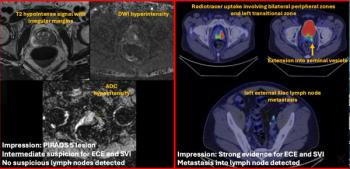Large Mammography Study Shows Significant Benefits with AI-Aided Screening
Reportedly the first randomized trial to examine the impact of artificial intelligence (AI) on screening mammography, researchers found AI-aided screening led to a 20 percent increase in breast cancer detection and a 44.3 percent decrease in mammography screening workload.
Adjunctive use of artificial intelligence (AI) led to a significant increase in breast cancer detection and a significant reduction in screening mammography workload in comparison to double mammography reading without AI, according to a newly reported study involving over 80,000 women in Sweden.
For the randomized, controlled study, recently published in
The study authors noted that AI was used to facilitate the triage of mammography exams to single radiologist review or review by two radiologists. They also pointed out that the radiologists had access to the AI case information at the time of their review.
For the AI-supported mammography screening group, researchers noted a total of 46,345 screen readings with 244 screen-detected breast cancer cases and 861 recalls. In contrast, the double mammography reading group without AI had a total of 83,231 screen readings with 203 screen-detected breast cancer cases and 817 recalls. The study authors found similar recall rates between the two groups (2.2 percent for AI-assisted mammography vs. 2 percent in the non-AI mammography group) and no difference in false positive rates (1.5 percent for both groups). However, the AI-aided mammography reading led to a significant difference in breast cancer detection.
“AI-supported screening resulted in 20% more cancers (244 vs. 203) being detected than with standard screening. 152 stage T1 invasive cancers were detected in the intervention group compared with 129 in the control group, which might indicate an increase in early detection without the need for supplementary imaging methods,” wrote lead study author Kristina Lang, Ph.D., an associate professor in the Division of Diagnostic Radiology in the Department of Translational Medicine at Lund University in Malmo, Sweden, and colleagues.
The study authors emphasized that the use of AI resulted in a 44.3 percent reduction in the screening mammography workload.
“We found that the benefit of AI-supported screening in terms of screen-reading workload reduction was considerable. The actual time saved was not measured, but, if we assume that a radiologist reads on average 50 screening examinations per hour, it would have taken one radiologist 4-6 months less to read the 46,345 screening examinations in the intervention group compared with the 83,231 in the control group,” noted Lang and colleagues.
Beyond the inherent limitations of a single center study, the researchers noted the use of one type of mammography device (Senographe Pristina) and one AI system for the study. The study authors also noted possible bias in assessing reader performance due to limiting single mammography reading in the intervention group to radiologists with more than two years of experience.
Newsletter
Stay at the forefront of radiology with the Diagnostic Imaging newsletter, delivering the latest news, clinical insights, and imaging advancements for today’s radiologists.





























